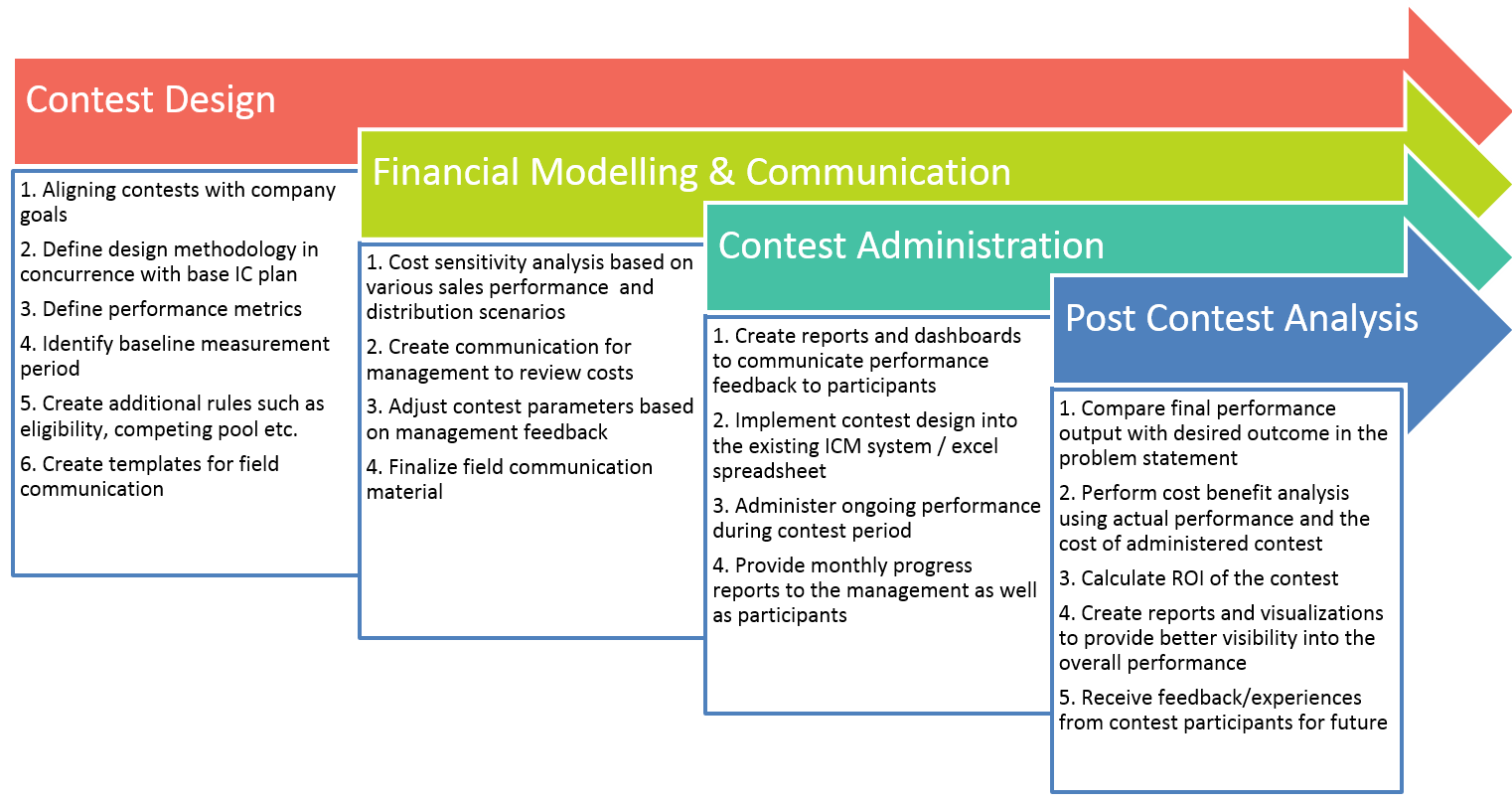Sales contests definition – Design & Analysis Amit Jain November 21, 2014
- To temporarily motivate salespeople to react appropriately to external market events. E.g., In the case of the launch of a new competitor, the focus should be on maintaining market share.
- Give sales performance a shot in the arm. E.g., Several companies run contests mid-year when performance to budget needs to catch up.
- Provide temporary focus to a lagging product line.
- Sometimes sales SPIFs can be used as a base IC plan for a new product that went to market very quickly, and the base IC plan is still playing catch up.
At a high level, the process below should be followed to ensure that content is effective:
Define a clear contest Objective
Define the contest objective clearly, along with the desired business goal. As far as possible, try to define the business objective in numeric terms as well. This helps judge the success of the contest more objectively. For e.g. Improve air conditioning sales by 25% YOY during the summer months.
Budget, Budget, Budget!
Next, decide on the budget for this contest. What investment are you willing to make to achieve this desired business goal? The success of a contest is defined as achieving the desired business objective while remaining within budget.
What are the details?
Once the problem statement is defined, the next step is to design various aspects of the contest:
- Design methodology – As far as possible, the SPIF/contest should complement the base IC plan and should not send out a conflicting message
- Performance Metric – Pick a performance metric that is clearly aligned with the business objective, along with a definition of data sources being used for calculations
- Period – Communicate the effective start and end date of the contest and the payout timelines for the contest/SPIF
- Applicable Rules – Define the rules in as detailed a manner as possible. Specify at least:
- Eligibility – Who is eligible to win the contest and who is not
- Competing for pool – In case of competitive contests, clearly define the pool within which your performance will be compared
- Number of winners – Define the number or percentage of winners from each pool.
- Reward – Cash, Non-Cash, Recognition, Commission per unit
How much is this going to cost us?
Perform cost sensitivity analysis based on various sales performance scenarios to understand cash outflow better and avoid the risk of facing cost overruns. Use this model to tweak the contest parameters to achieve acceptable spending. This model can also help you build a business case for contest implementation.
This model should also be used to ensure that the performance metric is unbiased to any specific geography/group and that the contest will not create any undesirable behaviour from the participating salesforce.
Communication
The most critical step for the success of a sales contest is communication. There should be clear messaging about the underlying business objective, eligibility, associated business rules, the competing pool and the reward associated with the contest. The participating sales team should clearly understand the performance metric (sales performance or activity based) and perceive the metric as fair. Be open to offering additional training to engage the broader salesforce, especially for new launch products.
Your contests will be more effective if they are exciting!
Ensure that you inculcate excitement in your contest communications as well. Using sports or entertainment analogies in contest communications can help here. The aim should be to get your salesforce excited about your contest.
Create a buzz around the program by utilizing multiple communication channels:
- Second-line manager – direct communication
- Company Intranet
- IC Scorecards (via notes/comments)
- Email blasts
- Social Media
How are we doing?
Along with the contest detail communication, the focus should be on creating effective reports and dashboards to communicate feedback:
- Dashboard with performance measurement and clear contest standing
- Ranking Report
- Additional section in existing IC Scorecards or sales performance reporting
Let’s build and run this thing!
Ideally, you should use your existing ICM system to implement your sales contests. This will ensure that data sources and rules applied for your contest are consistent with the base IC Plan definition of those rules. Timely progress reports to management and participating employees on the contest standings and projections will help maintain salesforce focus on the contest.
Ok! Was it worth it?
Once the contest period is over, go back to the contest objective and desired outcome identified in the first step. Measure success in comparison to the assigned business objective. Analyze improved sales performance and success metrics and the cost of the contest as compared to the budget allocated. Slice your contest winner’s performance in many ways to analyze the overall impact of the contest. As part of this step, it’s also important to seek feedback from the participating team on their experience so that contests can be made more effective in future.
This blog post discussed how to make the contest design and management process more streamlined and effective.
Below is a visual framework of how Incentius can help design and manage sales contests for your organization. Get in touch with us at info@incentius.com



